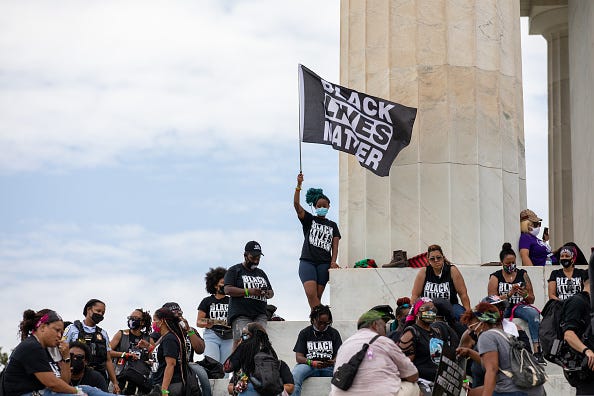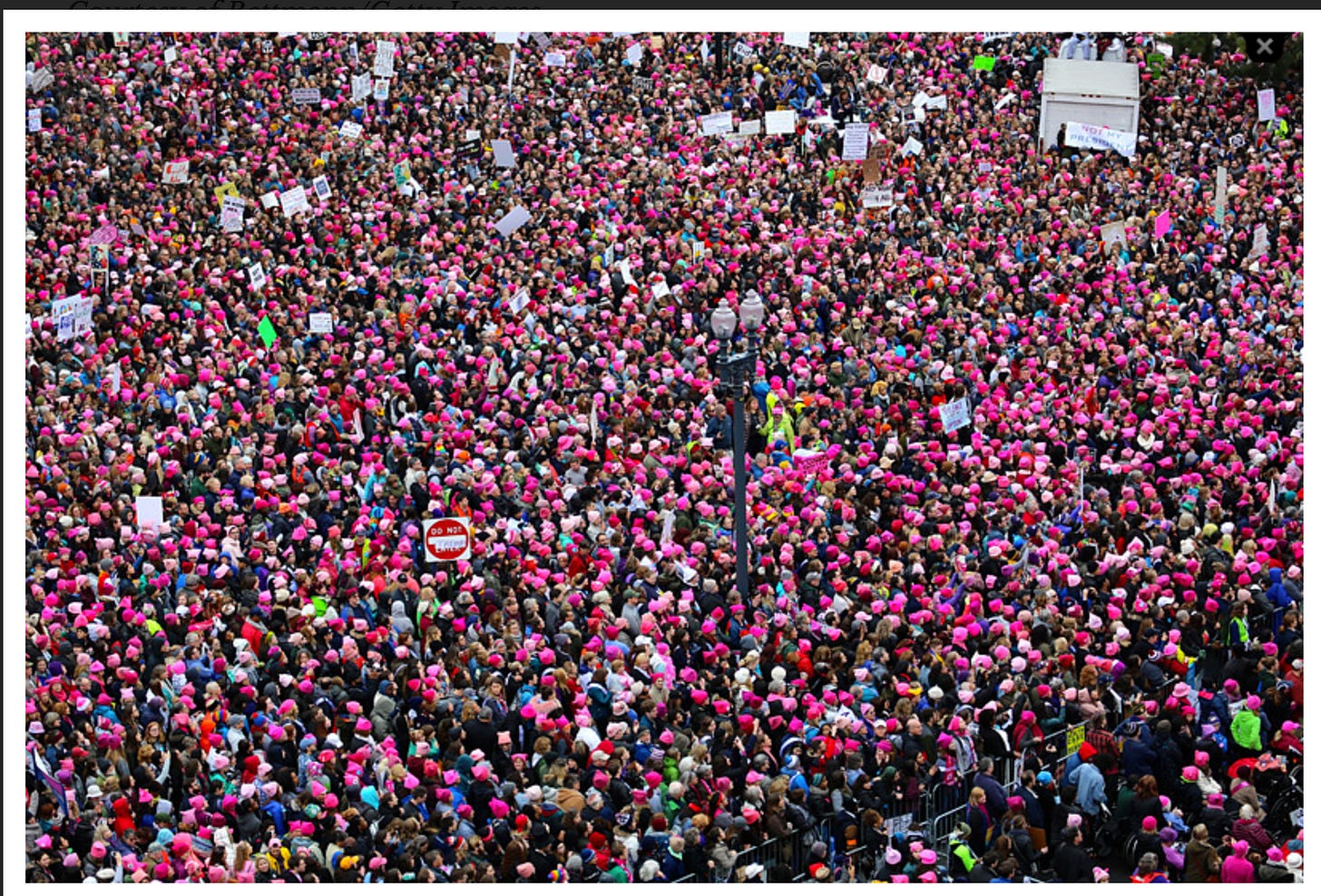In 2017 and 2020, Nonviolent Protests Influenced Elections. They are a Powerful Tool When Our Rights are Threatened
Today's essay is excerpted from a keynote speech on democracy protection I gave (virtually) at the Center for Community and Nonprofit Studies at the University of Wisconsin-Madison on April 28, 2022.
I wrote the talk and this essay, which revisits the January 2017 Women's March and the Black Lives Matter protests, before I heard about the Supreme Court draft of a majority opinion that would overturn Roe vs. Wade. That would leave abortion policy up to individual states. 13 US states currently have so-called "trigger laws" that take effect if Roe vs. Wade is overturned. In all, more than half of the country could see women's reproductive rights taken away if this decision goes through.
This is how I ended the essay. The message is more urgent than ever:
Nonviolent protests can remind Americans how precious their rights are and what they stand to lose in 2022 and beyond.
_________________________________________
We're living through historic times. The clash between democracy and autocracy seems to be peaking. Putin's war of annihilation against Ukraine has made the costs of unfreedom tragically clear. In the United States, we are the in throes of a civic emergency. It is our responsibility to act to save our democracy.
Democratic lawmakers have authored legislation meant to correct the weaknesses of our institutions and electoral system and respond to the assault on our rights. Think of 2021's Protecting Our Democracy Act, which addresses points of vulnerability that Donald Trump’s autocratic ambitions exposed, such as presidential abuses of pardons and states of emergency. There is also 2021's John R. Lewis Voting Rights Advancement Act. These measures passed the House but not the Senate, and so cannot become the law of the land right now.
The pace of justice can be slow. Many feel frustration with the Department of Justice's caution with regard to prosecuting those involved in the Jan. 6 coup attempt.
That is why public nonviolent protests are necessary and why they have proved effective wherever there are threats to democracy.
We are living through a wave of global activism that a 2020 report calls “historically unprecedented in frequency, scope and size.” In 2019, demonstrations against economic inequality in Chile were the largest since the 1980s protests against the military dictatorship. They created momentum that led to the 2022 election of a 35-year old former labor activist, Gabriel Boric, as president.
Even the pandemic didn’t stop those driven to protest police brutality in Nigeria, climate change around the world, and racism in America. Tens of thousands of Indian farmers protested Narendra Modi's policies, and activists working against the February 2021 coup in Myanmar used digital tools to facilitate boycotts of businesses linked to the military.
More recently, there is the unexpected global surge of solidarity with Ukraine, which extends to almost 1,000 US businesses disrupting their profits by leaving Russia. It’s not just autocracy that's contagious. Doing the right thing for democracy can also prevail.
We must connect the dots among those global actions and what's going on in our own country. Nonviolent mass protests will bolster ongoing efforts at the level of congressional inquiry and legislation to defeat autocracy at home.
We can build on two recent examples of nonviolent civil resistance in the US that resulted in tangible gains for democracy. First, the January 2017 Women’s March. With 400,000-500,000 people joining in Washington DC and up to 5 million participating in over 400 other marches around the country --and more than 400 partner organizations-- it was the largest organized protest in American history up to that point in time.
The Women's March changed the face of American politics. Many of the more than 3,000 women who ran for office in the fall 2018 midterms had been inspired by that march to enter politics. Over 90 women were voted into office, including a record number of women of color and the first Muslim women representatives. Organizations such as Run for Something, which mentors progressive politicians, continue that energy.
Why was the March successful? It channeled American civil rights and feminist activism. It had a symbol --pink pussy hats-- that turned Trump's history of assaulting and scorning women against him. It modeled cooperation on a massive scale and unity of purpose.
The Women's March was a preventive protest that aimed to alert people that our rights would be in jeopardy under a misogynist leader. A new round of mass protest can rouse voters for the midterms, warning them what could happen if the GOP comes to control Congress.
Most mass protests are sparked by an event that is so unjust or tragic that it compels people to come into the streets, full of outrage and passion. That was the case with the Black Lives Matter protests. They were prompted by the murder of George Floyd, which was recorded on video (by Darnella Frazier) before the police could fabricate their own narrative.
Those local protests against police brutality soon expanded into national demonstrations that expressed anger at institutionalized racism, brutal policing, and fears about what Trump's normalization of extremism would mean for non-whites. The Black Lives Matter protests came to involve over 20 million people in multigenerational and multiracial displays of solidarity They became the largest social protest movement in American history, and they fueled voter turnout in the 2020 election.

As every activist knows, protest is exhausting. And it is an increasingly dangerous activity in America, where anti-protest laws are multiplying and some states now allow demonstrators to be run over by cars without their drivers facing criminal penalties.
That is why we need to remember the successes these two recent mass protests produced in terms of electoral politics, and find a way to harness that energy now.
Autocracy thrives when people lose hope that things can ever be different. Resistance in its many forms keeps alive the possibility of change and inspires others to work for a better future.
Some may be impatient with our political class and institutions, but they are working on legislation and investigations meant to protect our democracy. And we should never take for granted that we can read about these activities, and the investigative work of journalists, every day in the American media. That is not possible in Russia, China, and many other countries.
We can bolster these efforts with our own parallel actions. Nonviolent protests can remind Americans how precious their rights are and what they stand to lose in 2022 and beyond.



Thank you Ruth. This is a wake up call for civic action and protest now in the wake of Roe v. Wade being overturned and the loss of not only reproductive rights for women but many privacy rights as well. The tragedy of Roe v. Wade being overturned is that state legislatures now will become the arbiters of privacy rights and individual freedoms that we have taken for granted for 50 years. No longer can we expect the federal government to be the protector of our privacy rights or civil liberties.
Ahead of the midterm elections, now is the time for action and national protest all across the country like never before! Our freedoms, our liberties our very democracy are all on the chopping block!
The USA is literally 6 months and 5 days away from the midterm elections. What goes on between then and now will have an impact for generations to come. Maybe some of the 100,000,000 Americans who don’t vote will finally get off their butts? Truthfully, I am not holding my breath. The Republicans promised their constituents they would fight to overturn Roe vs Wade along with a host of other major changes. I am not surprised in the least and truly saddened to watch the USA turn into a theocracy.